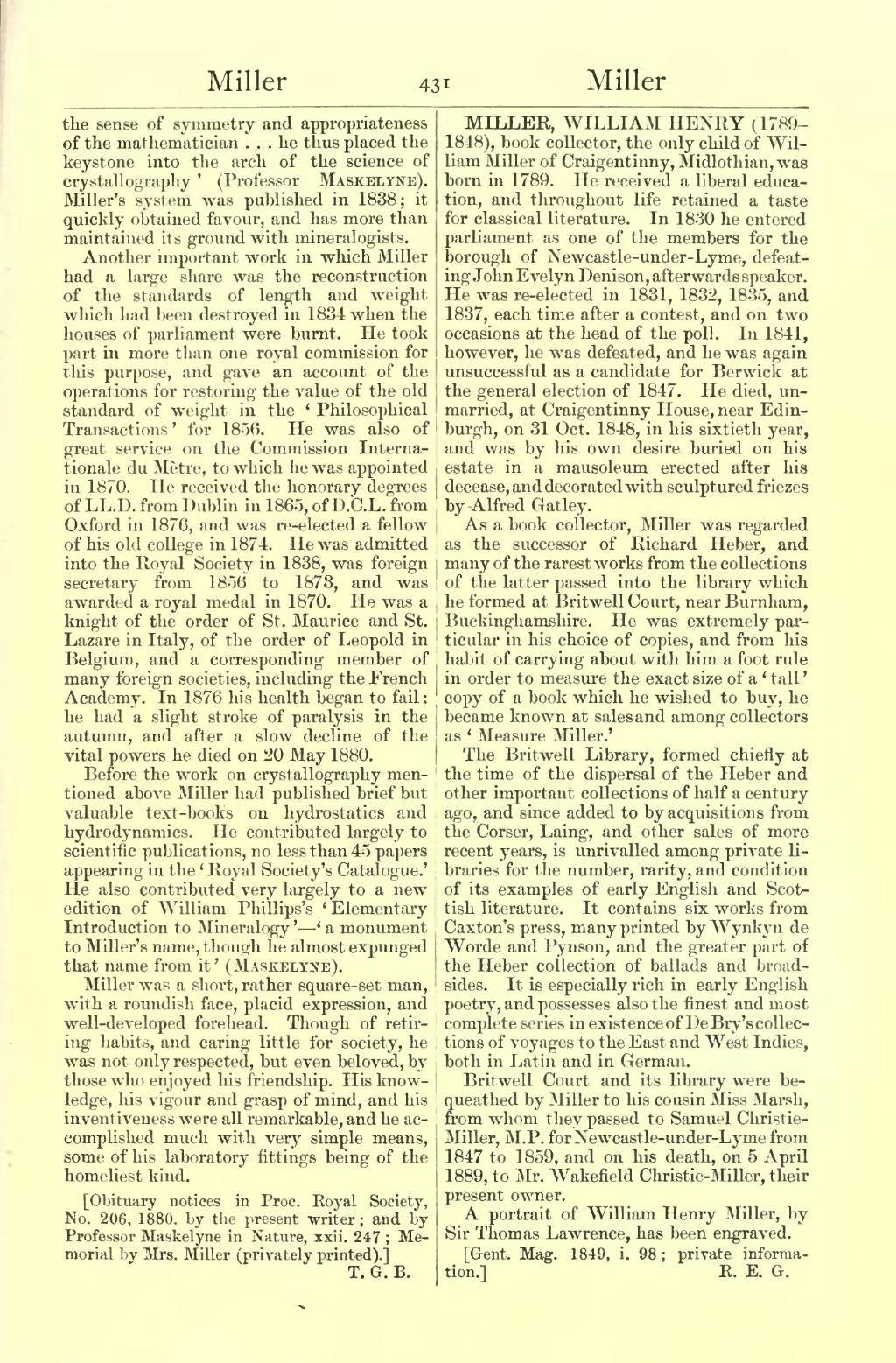the sense of symmetry and appropriateness of the mathematician … he thus placed the keystone into the arch of the science of crystallography’ (Professor Maskelyne). Miller's system was published in 1838; it quickly obtained favour, and has more than maintained its ground with mineralogists.
Another important work in which Miller had a large share was the reconstruction of the standards of length and weight which had been destroyed in 1834 when the houses of parliament were burnt. He took part in more than one royal commission for this purpose, and gave an account of the operations for restoring the value of the old standard of weight in the ‘Philosophical Transactions’ for 1856. He was also of great service on the Commission Internationale du Mètre, to which he was appointed in 1870. He received the honorary degrees of LL.D. from Dublin in 1865, of D.C.L. from Oxford in 1876, and was re-elected a fellow of his old college in 1874. He was admitted into the Royal Society in 1838, was foreign secretary from 1856 to 1873, and was awarded a royal medal in 1870. He was a knight of the order of St. Maurice and St. Lazare in Italy, of the order of Leopold in Belgium, and a corresponding member of many foreign societies, including the French Academy. In 1876 his health began to fail; he had a slight stroke of paralysis in the autumn, and after a slow decline of the vital powers he died on 20 May 1880.
Before the work on crystallography mentioned above Miller had published brief but valuable text-books on hydrostatics and hydrodynamics. He contributed largely to scientific publications, no less than 45 papers appearing in the ‘Royal Society's Catalogue.’ He also contributed very largely to a new edition of William Phillips's ‘Elementary Introduction to Mineralogy’—‘a monument to Miller's name, though he almost expunged that name from it’ (Maskelyne).
Miller was a short, rather square-set man, with a roundish face, placid expression, and well-developed forehead. Though of retiring habits, and caring little for society, he was not only respected, but even beloved, by those who enjoyed his friendship. His knowledge, his vigour and grasp of mind, and his inventiveness were all remarkable, and he accomplished much with very simple means, some of his laboratory fittings being of the homeliest kind.
[Obituary notices in Proc. Royal Society, No. 206, 1880, by the present writer; and by Professor Maskelyne in Nature, xxii. 247; Memorial by Mrs. Miller (privately printed).]
MILLER, WILLIAM HENRY (1789–1848), book collector, the only child of William Miller of Craigentinny, Midlothian, was born in 1789. He received a liberal education, and throughout life retained a taste for classical literature. In 1830 he entered parliament as one of the members for the borough of Newcastle-under-Lyme, defeating John Evelyn Denison, afterwards speaker. He was re-elected in 1831, 1832, 1835, and 1837, each time after a contest, and on two occasions at the head of the poll. In 1841, however, he was defeated, and he was again unsuccessful as a candidate for Berwick at the general election of 1847. He died, unmarried, at Craigentinny House, near Edinburgh, on 31 Oct. 1848, in his sixtieth year, and was by his own desire buried on his estate in a mausoleum erected after his decease, and decorated with sculptured friezes by Alfred Gatley.
As a book collector, Miller was regarded as the successor of Richard Heber, and many of the rarest works from the collections of the latter passed into the library which he formed at Britwell Court, near Burnham, Buckinghamshire. He was extremely particular in his choice of copies, and from his habit of carrying about with him a foot rule in order to measure the exact size of a ‘tall’ copy of a book which he wished to buy, he became known at sales and among collectors as ‘Measure Miller.’
The Britwell Library, formed chiefly at the time of the dispersal of the Heber and other important collections of half a century ago, and since added to by acquisitions from the Corser, Laing, and other sales of more recent years, is unrivalled among private libraries for the number, rarity, and condition of its examples of early English and Scottish literature. It contains six works from Caxton's press, many printed by Wynkyn de Worde and Pynson, and the greater part of the Heber collection of ballads and broadsides. It is especially rich in early English poetry, and possesses also the finest and most complete series in existence of DeBry's collections of voyages to the East and West Indies, both in Latin and in German.
Britwell Court and its library were bequeathed by Miller to his cousin Miss Marsh, from whom they passed to Samuel Christie-Miller, M.P. for Newcastle-under-Lyme from 1847 to 1859, and on his death, on 5 April 1889, to Mr. Wakefield Christie-Miller, their present owner.
A portrait of William Henry Miller, by Sir Thomas Lawrence, has been engraved.
[Gent. Mag. 1849, i. 98 ; private information.]
